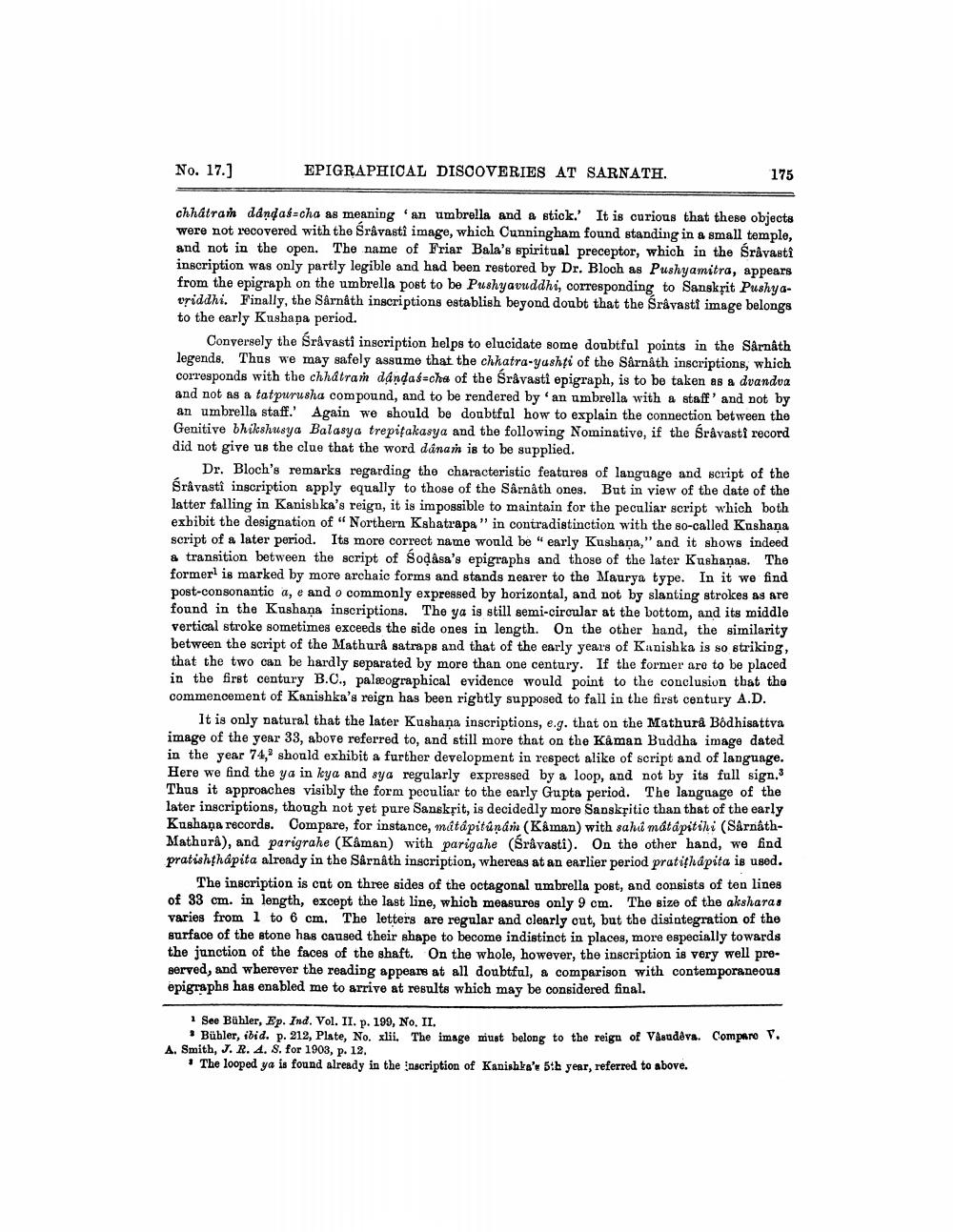________________
No. 17.)
EPIGRAPHICAL DISCOVERIES AT SARNATH.
175
chhatram dandas-cha as meaning an umbrella and a stick.' It is curious that these objects were not recovered with the Srâvastî image, which Cunningham found standing in a small temple, and not in the open. The name of Friar Bala's spiritual preceptor, which in the Sråvasti inscription was only partly legible and had been restored by Dr. Bloch as Pushyamitra, appears from the epigraph on the umbrella post to be Pushyavuddhi, corresponding to Sanskrit Pushyavriddhi. Finally, the Sárnáth inscriptions establish beyond doubt that the Srâvasti image belongs to the early Kushapa period.
Conversely the Sråvasti inscription helps to elucidate some doubtfal points in the Sârnâth legends. Thus we may safely assume that the chhatra-yushti of the Sárnáth inscriptions, which corresponds with the chhatram dandas-cha of the Sråvasti epigraph, is to be taken as a dvandva and not as a tatpurusha compound, and to be rendered by an umbrella with a staff' and not by an umbrella staff.' Again we should be doubtful how to explain the connection between the Genitive bhikshusya Balasya trepitakasya and the following Nominative, if the Sråvasti record did not give us the clue that the word danam is to be supplied.
Dr. Bloch's remarks regarding the characteristic features of language and script of the Śråvastî inscription apply equally to those of the Sárnáth ones. But in view of the date of the latter falling in Kanishka's reign, it is impossible to maintain for the peculiar script which both exhibit the designation of " Northern Kshatrapa" in contradistinction with the so-called Kushana script of a later period. Its more correct name would be "early Kushana," and it shows indeed & transition between the script of Sodasa's epigraphs and those of the later Kushaņas. The formerl is marked by more archaic forms and stands nearer to the Maurya type. In it we find post-consonantic a, e and o commonly expressed by horizontal, and not by slanting strokes as are found in the Kushana inscriptions. The ya is still semi-circular at the bottom, and its middle vertical stroke sometimes exceeds the side ones in length. On the other hand, the similarity between the script of the Mathura satraps and that of the early years of Kanishka is so striking, that the two can be hardly separated by more than one century. If the former are to be placed in the first century B.C., palæographical evidence would point to the conclusion that the commencement of Kanishka's reign has been rightly supposed to fall in the first century A.D.
It is only natural that the later Kushana inscriptions, e.g. that on the Mathura Bodhisattva image of the year 33, above referred to, and still more that on the Kaman Buddha image dated in the year 74,9 should exhibit a further development in respect alike of script and of language. Here we find the ya in kya and sya regularly expressed by a loop, and not by its full sign. Thus it approaches visibly the form peculiar to the early Gupta period. The language of the later inscriptions, though not yet pure Sanskrit, is decidedly more Sanskritic than that of the early Kushana records. Compare, for instance, matapitánária (Kiman) with sahi matapitihi (SarnathMathura), and parigrahe (Kaman) with parigahe (Śråvasti). On the other hand, we find pratishthápita already in the Sârnâth inscription, whereas at an earlier period pratithápita is used.
The inscription is ont on three sides of the octagonal umbrella post, and consists of ten lines of 33 cm. in length, except the last line, which measures only 9 cm. The size of the aksharas varies from 1 to 6 cm. The letters are regular and clearly out, but the disintegration of the surface of the stone has caused their shape to become indistinct in places, more especially towards the junction of the faces of the shaft. On the whole, however, the inscription is very well preserved, and wherever the reading appears at all doubtful, a comparison with contemporaneous epigraphs has enabled me to arrive at results which may be considered final.
1 See Bühler, Ep. Ind. Vol. II. p. 199, No. II.
• Bübler, ibid. p. 212, Plate, No. xlii. The image must belong to the reign of Vasudeva. Compare Y. A. Smith, J. R. 4. S. for 1903, p. 12.
The looped ya is found already in the Inscription of Kanishka's 5th year, referred to above.




